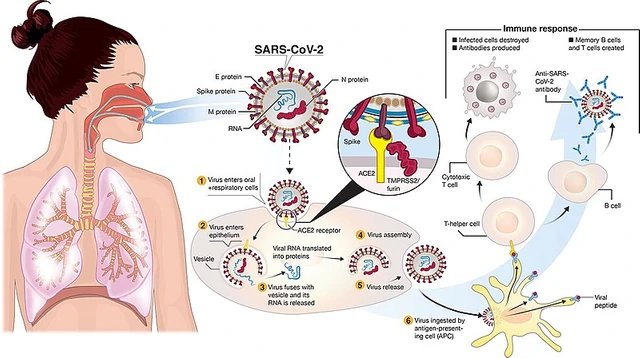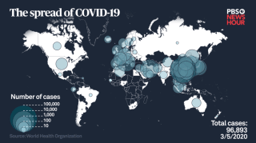Coronavirus (COVID-19)

Coronavirus (COVID-19)
Coronavirus (COVID-19) is an highly contagious Disease caused by severe acute respiratory syndrome coronavirus 2 (SARS-CoV-2). It first emerged in 2019 in Wuhan, China, and within a couple of months spread around the globe, eventually being labeled a pandemic by the World Health Organization (WHO). [1]
Symptoms
The most common symptoms are fever, cough, and shortness of breath. However, less reported symptoms are muscle pain, sputum and sore throat. Gastrointestinal symptoms such as nausea, vomiting, and diarrhea have been reported in a small number of cases. Most cases only result in minor symptoms, however, some cases are progressing to deadly pneumonia and organ failure. [7]
There are several videos and articles you can look into where people who have experienced the virus share their perspective.
Transmission
The virus is spread through respiratory droplets produced from coughing, Sneeze and talking. It is also spread through contaminated surfaces and then touching ones face. COVID-19 can survive on a cardboard delivery box for at least a day and lives even longer on steel and plastic.[14] After exposure, symptoms can take from 2 to 14 days to show up, with an average of 5 days. Many people affected by the virus remain asymptomatic for the duration of the infection.
While asymptomatic, the infected are contagious, making containment difficult if you are only trying to isolate those showing symptoms.
The countries or cities that fared the best during the pandemic, are those whose citizens had advanced warning, and took precautions to reduce contagion, early, before a large number of cases took effect.[15]
Diagnosis
Infected patients are diagnosed by reverse transcription polymerase chain reaction (rRT-PCR) from a nasopharyngeal swab. A diagnosis can also be deduced through a combination of symptoms, environmental risk factors as well as a chest CT scan with features of pneumonia. [6]
Infection
COVID-19 is dangerous because the virus accesses host cells with the enzyme ACE2, most abundantly found in the type II alveolar cells of the lungs.
The virus enters the host cell through a special surface glycoprotein, called "spike". As the lungs succumb to the disease, respiratory failure and death may follow. Recovered patients may be subject to permanent lung damage from Pulmonary fibrosis. [9]
Ventilation
Some cases of COVID-19 are severe enough that patients require mechanical ventilation.
Although it is most common in adults aged 60 years and older, there are are also several reported cases of young people requiring breathing assistance too.
Most hospitals do not have enough beds to accommodate a sudden spike in illnesses that require hospitalization., which limits a health system's capacity to handle a sudden spike in severe COVID-19 cases.
Many countries are experiencing a shortage of ventilators.
Prevention
Social distancing and thorough Hygiene measures are suggested to prevent infection. People are advised to stay at least 6 feet away from others, wash their hands often with warm soap and water for at least 20 seconds and keep hands away from their faces. Hand sanitizer is also advised in situations where there is no access to soap and water. Masks are recommended but due to supply shortages in the United States experts advise the general population not to hoard them and donate if they can. An Everipedia blog post titled "This Is Corona Virus Survival Guide" has more information on the subject. As at March 20th, 2020 there was no vaccine or antiviral treatment for COVID-19. [12]
Much of the strategy being employed is an attempt to flatten the epidemic curve and reduce the amount of new infections.
Slowing the infection rate eases pressure being placed on health services, essentially buying time and allowing the country to perform better healthcare for people who are afflicted.
If one suspect they has symptoms of the virus, the CDC asks them to call ahead before visiting their local health care provider.
Beginnings
The virus was first transmitted to humans in Wuhan, in November or December of 2019. It is believed to be natural and the product of spillover infection from an animal origin. Vox Media did an investigation into Chinese wet markets centered around trading and eating exotic animals, suggesting that is where it might have originated. [4] On February 25th of 2020, China banned the trade and consumption of wild animals. The earliest known infection occurred on 17 November 2019. By early January 2020, China was seeing a lot of human-to-human transmission. By mid-January it was recorded spreading outside of China to other countries such as Japan and Thailand. By mid-March of 2020, countries like China, Denmark, El Salvador, France, Republic of Ireland, Italy, New Zealand, Poland, and Spain began implementing heavy quarantine measures. [8]
Evolution
Youtube channel Roylab Stats has been hosting a livestream of updated stats since January 30th.
As of March 20th, 2020 it showed 277,537 confirmed cases, 11,386 deaths, 91,002 recoveries.
Famous People With COVID-19
Dozens of athletes, actors, politicians, executives and others from all walks of life have come down with COVID-19 including some big names like Tom Hanks, Rita Wilson, Kevin Durant, Lucian Grainge, Idris Elba and many more. You can find them on the List of Public Figures and Celebrities Who Contracted COVID-19.
Vaccine
A COVID‑19 Vaccine is a vaccine intended to provide acquired immunity against severe acute respiratory syndrome coronavirus 2 (SARS‑CoV‑2), the virus causing coronavirus disease 2019 (COVID‑19). Prior to the COVID‑19 pandemic, there was an established body of knowledge about the structure and function of coronaviruses causing diseases like Severe acute respiratory syndrome (SARS) and Middle East respiratory syndrome (MERS), which enabled accelerated development of various vaccine technologies during early 2020. On 10 January 2020, the SARS-CoV-2 genetic sequence data was shared through GISAID, and by 19 March, the global pharmaceutical industry announced a major commitment to address COVID-19.
In Phase III trials, several COVID‑19 vaccines have demonstrated efficacy as high as 95% in preventing symptomatic COVID‑19 infections.
As of March 2021, 12 vaccines were authorized by at least one national regulatory authority for public use: two RNA vaccines (the Pfizer–BioNTech vaccine and the Moderna vaccine), four conventional inactivated vaccines (BBIBP-CorV, CoronaVac, Covaxin, and CoviVac), four viral vector vaccines (Sputnik V, the Oxford–AstraZeneca vaccine, Convidicea, and the Johnson & Johnson vaccine), and two protein subunit vaccines (EpiVacCorona and RBD-Dimer).
In total, as of March 2021, 308 vaccine candidates were in various stages of development, with 73 in clinical research, including 24 in Phase I trials, 33 in Phase I–II trials, and 16 in Phase III development.
Many countries have implemented phased distribution plans that prioritize those at highest risk of complications, such as the elderly, and those at high risk of exposure and transmission, such as healthcare workers.
As of 20 March 2021, 436.37 million doses of COVID‑19 vaccine have been administered worldwide based on official reports from national health agencies.
AstraZeneca-Oxford anticipates producing 3 billion doses in 2021, Pfizer-BioNTech 1.3 billion doses, and Sputnik V, Sinopharm, Sinovac, and Johnson & Johnson 1 billion doses each. Moderna Therapeutics targets producing 600 million doses and Convidicea 500 million doses in 2021. By December 2020, more than 10 billion vaccine doses had been preordered by countries, with about half of the doses purchased by high-income countries comprising 14% of the world's population.
See Also
Jeffrey Ghazarian
COVID-19 Cases In The United States
Cancellations Postponements & Closures due to COVID-19





